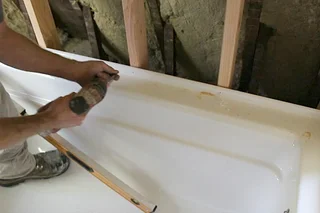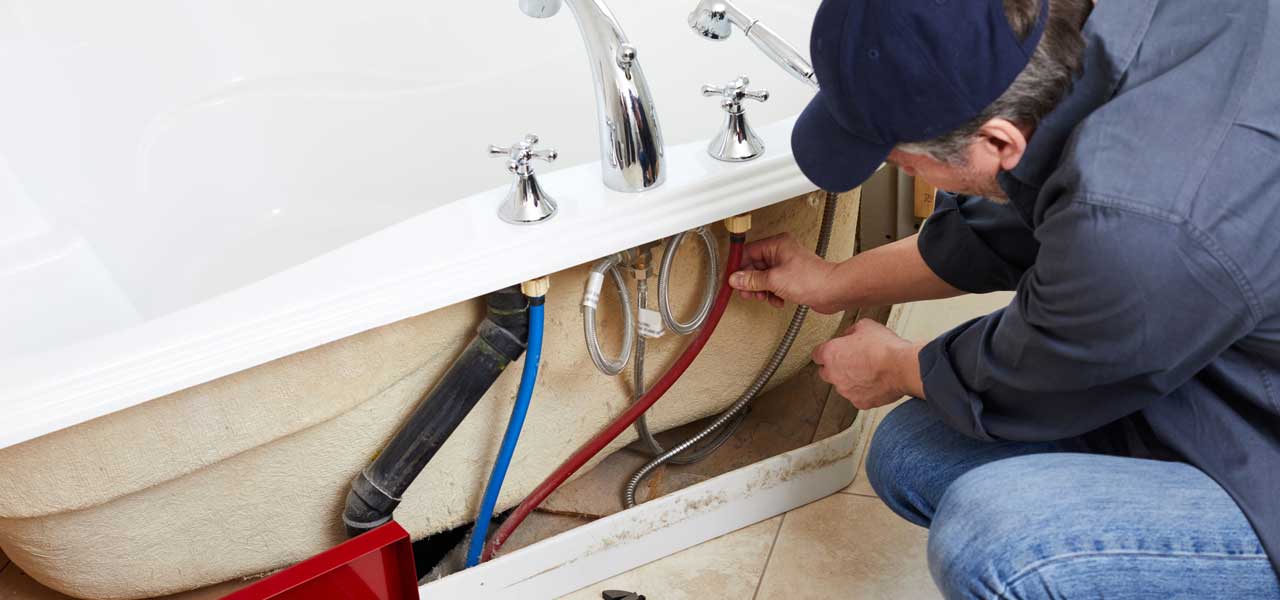Plumbing 101: A Guide to Bathtub Installation
Plumbing 101: A Guide to Bathtub Installation
Blog Article
What're your thoughts regarding How to Install a Bathtub Yourself?

Installing a bathtub isn't specifically brain surgery, however it does need solid plumbing, carpentry, and also occasionally, tiling skills. Replacing an old bath tub with a new one is additionally a reasonably challenging project. If the old bathtub is easily available, the task can move rapidly; if you have to open up a wall surface to eliminate the old tub and also place the new bath tub, the task is a lot harder. In either situation, the project is within a residence handyman's skills, although you will certainly need a helper to move out the old bathtub as well as set in the new one. Make sure you have actually certified yourself for the work as well as are comfortable trying it. Instead of employing a professional to take over a halfway-completed task, it is much better to consider using one before you start. Possibilities are you might need a specialist plumber to make tube connections.
This write-up will certainly assist you mount a brand-new tub in your shower room if you have currently gotten a new tub and also don't need to transform the arrangement of your previous water pipes.
Your tools and also product checklist must consist of the following:
Removing Old Taps
If you need to replace old taps with new ones as a part of your setup, then the first thing you should do is disconnect the water supply. After doing so, turn on the taps to drain any water remaining in the system. The procedure of getting rid of the existing faucets can be rather troublesome as a result of the limited gain access to that is typically the situation.
Use a container wrench (crowsfoot spanner) or a faucet tool to undo the nut that attaches the supply pipes to the taps. Have a cloth all set for the staying water that will originate from the pipes. Once the supply pipelines have been gotten rid of, utilize the very same tool to loosen the nut that holds the faucets onto the bath/basin. You will require to stop the solitary taps from transforming during this procedure. Once the taps have actually been eliminated, the holes in the bath/basin will have to be cleansed of any old securing compound.
Prior to going on to fit the new taps, compare the pipe connections on the old taps to the new taps. If the old faucets are longer than the brand-new faucets, after that a shank adapter is needed for the new taps to fit.
Suitable New Touches
If the tails of the brand-new taps are plastic, then you will certainly require a plastic adapter to avoid damage to the thread. One end of the adapter fits on the plastic tail of the tap as well as the other end supplies a link to the current supply pipelines.
If you require to fit a monobloc, after that you will certainly need minimizing couplers, which links the 10mm pipe of the monobloc to the typical 15mm supply pipeline.
Next off, place the tap in the mounting hole in the bath/basin ensuring that the washing machines remain in location between the faucet as well as the sink. Secure the faucet in position with the producer provided backnut. As soon as the faucet is securely in position, the supply pipes can be connected to the tails of the taps. The faucets can either be linked by utilizing corrugated copper piping or with typical tap adapters. The former kind ought to be attached to the tap finishes first, tightening just by hand. The supply pipes can later on be attached to the other end. Tighten both ends with a spanner after both ends have been attached.
Setting up the Tub
Utilizing the two wood boards under its feet, position the bath tub in the called for placement. The wood boards are helpful in evenly spreading the weight of the bathtub over the area of the boards as opposed to concentrating all the weight onto four little points.
The next objective is to make certain that the tub is leveled all round. This can be accomplished by inspecting the spirit level and readjusting the feet on the tub till the level reads degree.
To set up faucets, fit the bottom of the outermost versatile tap adapter to the appropriate supply pipe by making a compression sign up with; after that do the exact same for the other tap.
Switch on the supply of water and also inspect all joints as well as brand-new pipework for leakages and also tighten them if necessary. Fill the tub and also check the overflow electrical outlet and also the typical electrical outlet for leaks.
Finally, deal with the bath paneling as explained in the producer's user's manual. Tiling and securing around the bathtub needs to wait until the tub has actually been used at the very least once as this will certainly resolve it right into its final setting.
Planning for the Installation
Firstly, the sustaining frame provided with the bathroom ought to be fitted (if called for) according to the supplier's guidelines. Next, fit the taps or mixer to the bathtub. When suitable the faucet block, it is essential to ensure that if the tap includes a plastic washer, it is fitted between the bath and the faucets. On a plastic bath, it is also practical to fit a supporting plate under the taps device to stop strain on the bath tub.
Fit the versatile tap ports to the bottom of both taps utilizing 2 nuts and also olives (often supplied with the tub). Fit the plug-hole electrical outlet by smearing mastic filler round the sink electrical outlet hole, and afterwards pass the outlet with the hole in the bath. Make use of the nut supplied by the maker to fit the plug-hole. Analyze the plug-hole outlet for an inlet on the side for the overflow pipe.
Next off, fit the end of the versatile overflow pipeline to the overflow outlet. After that, screw the pipeline to the overflow face which need to be fitted inside the bathroom. Make sure you make use of every one of the provided washing machines.
Connect the trap to the bottom of the waste outlet on the tub by winding the string of the waste electrical outlet with silicone mastic or PTFE tape, and also screw on the catch to the electrical outlet. Connect all-time low of the overflow tube in a comparable manner.The bathroom should currently be ready to be suited its last placement.
Tiling Around the Bath tub
In the location where the bathroom satisfies the tile, it is necessary to seal the accompanies a silicone rubber caulking. This is important as the installation can relocate enough to break a rigid seal, creating the water to permeate the wall in between the bath and also the tiling, leading to issues with dampness and feasible leaks to the ceiling listed below.
You can pick from a range of coloured sealants to assimilate your components as well as installations. They are sold in tubes as well as cartridges, and can securing gaps approximately a width of 3mm (1/8 inch). If you have a larger void to fill, you can fill it with spins of drenched newspaper or soft rope. Keep in mind to constantly load the bathtub with water prior to securing, to allow for the movement experienced when the tub is in use. The sealant can break relatively early if you do not take into consideration this motion before sealing.
Alternatively, ceramic coving or quadrant tiles can be used to border the bathroom or shower tray. Plastic strips of coving, which are easy to use as well as reduce to size, are also conveniently readily available on the marketplace. It is recommended to fit the tiles making use of waterproof or waterproof adhesive and also grout.
Bathtub Installation
How Important Is A Bathtub To Your Home?
High-quality baths, showers, and other bathroom updates are necessary when considering a smart investment in your home. It’s a room that you go to every day and one that is constantly being used by guests.The bathroom is one of the top trafficked rooms in a home and also one of the most valuable in terms of home resale.
Install Piping Before Tub
You will be using your existing drain and waste vent system, but pipes required include the hot and cold water supply lines and a pipe leading to a shower head. A mixing valve and shower head are also needed. Air chambers may be required.
Position the Tub
Lower the tub into place so that the continuous flange fits against the wall studs and rests on 1’x4' or 2’x4' supports. Anchor the tub to the enclosure with nails or screws inserted through the flanges into the studs.
NOTE: Remember, bathtubs and shower stalls may require support framing. A bathtub filled with water is extremely heavy, so check building codes and framing support before installing the tub.
Assemble Drain Connections
Assemble the bathtub drain connections by connecting the tub overflow with the tub drain above the trap, not beyond it. The trap will have a compression fitting that screws over the arm of the overflow assembly.
Place a Pipe For the Shower Head
First, locate a brass female threaded winged fitting and attach it to a framing support via a screw or a nail. Then run a pipe up the wall for the shower head. Sweat or solder the other side of the brass fitting to the top of the pipe.
Attaching Hot and Cold Water Lines
Attach your water lines for both hot and cold by sweating these directly into the hot and cold ports of the mixing valve. The mixing valve will be how water enters the tub’s system, not by the pipes themselves.
Install the Spout
Extend a piece of 1/2 inch pipe, or whichever length is specified in the manufacturer’s instructions, for the tub spout. Sweat on a male threaded fitting at the end of the pipe or use a brass nipple of the proper length and a 1/2 inch cap.
NOTE: At this point you should have your rough-in plumbing work inspected before proceeding further.
Check For Leaks
Restore the water pressure and check the drain connection and the supply pipes for any sign of leaking.
estore the Bathroom Wall
Replace the wall with moisture-resistant drywall as a base for your wall covering. Seal the joints between the wall and your new tub with silicone caulk as protection against water seepage.
https://www.berkeys.com/2016/12/02/bathtub-installation-dallas/

I hope you liked our topic about A Step-by-Step Guide to Installing a Bathtub. Many thanks for spending some time to read our blog post. I beg you take the time to share this blog post if you enjoyed reading it. Many thanks for your time. Kindly come by our site back soon.
This Page Report this page